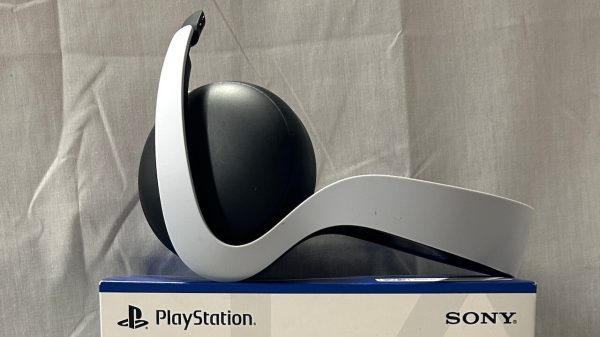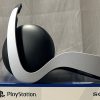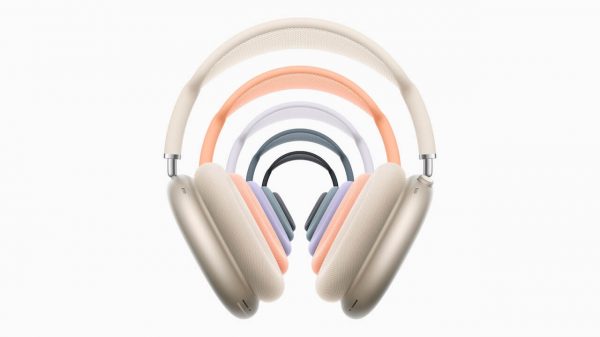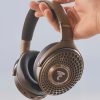Mark Levinson has been one of the leading brands in high-end audio for almost 50 years and its transition under the stewardship of Harman International has been rather interesting to watch. Harman is now owned by Samsung and part of a much larger group of companies that includes Harman Kardon, JBL, Lexicon, Infinity, Revel, and AKG. The growth of wireless headphones and the connection to Samsung and AKG is not a coincidence in regard to the Mark Levinson No. 5909 Wireless Headphones.
Following the departure of Mark Levinson who has not been associated with the company for many decades, the company took a few wrong turns but now seems to be on very solid ground. Levinson and Krell were fierce competitors in the 1980s battling it out for supremacy in the world of uber high-end audio solid state amplifiers, pre-amplifiers, and CD players.
Dan D’Agostino no longer owns Krell but has come roaring back with his own brand that is priced for those who take their Ferrari 458s or Maserati Grecale SUVs to the Hamptons on the weekend; D’Agostino has had a hand in many successful projects over the decades and his engineering prowess has proven to be first-rate.
Mark Levinson, with a lot of help from John Curl and other designers, focused on creating the world’s best solid-state amplifiers and pre-amplifiers with the intended goal of always recreating what was recorded in the studio.
My personal system utilizes a pair of Mark Levinson 23.5 Power Amplifiers which have served me very well for many years now; early models are highly sought after on the used market and fetch far more today than when they were first released if they have been properly serviced and are in excellent condition.

Fast forward to 2022, and Mark Levinson finds itself in a market with dozens of high-end companies that sell the same products with a renewed focus on streaming, home theater, analog playback, and personal audio.
Samsung, JBL, and AKG have a strong focus on the headphone and wireless categories and it was only a matter of time before a brand like Mark Levinson ventured into the space.
When Levinson commanded a sizable slice of the high-end market, it faced far fewer companies in the category; Krell, Spectral, McIntosh, Audio Research, and Conrad-Johnson were the big names of the period and Levinson was particularly good at marketing and getting high-end publications to buy his schtick.
It should not come as a surprise that the Mark Levinson No. 5909 Wireless Headphones are $999.95 USD when one looks at the rest of the lineup but that does raise the bar in the wireless category where most premium models retail for less than $500.
HiFiMAN tried with the Ananda BT which retailed for almost $900 at launch and it has been a hard sell; the price has dropped to $799 but the market has not shifted.
The No. 5909, however, are a huge shift for Mark Levinson who had never produced a headphone in over 50 years and it was certainly a bit of a risk to jump into the high-end headphone space with such a product aimed at wealthy music listeners who might be attracted to the product because of the pedigree.
Did they succeed?
The Skinny
Mark Levinson components have had a particular look for over 50 years and it was clear during the unboxing that the brand has not deviated too far with their first pair of headphones. The industrial design will feel very familiar to a lot of audiophiles and the build quality and components are all first rate.
Harman, AKG, and Levinson have one of the largest pools of talented engineers in the world and it is clear that this was a collaborative effort. This may be the first headphone rodeo for Mark Levinson but nothing about these headphones would suggest that this is a freshman effort.
Many brands will be including the Mark Levinson No. 5909 in their R&D testing in the future when it comes to design, build quality, and wireless performance.
The frame is all metal with a spring steel headband and anodized aluminum gimbals and height adjustments; the cups are metal framed as well for durability with the pads and headband made of soft leather with memory foam for improved comfort.

The ear pads snap on and off easily when needed and unlike most brands there is a secondary pad that fits between the drivers and the cups. The baffles are sunken in the center where the driver is mounted with the driver sitting almost an inch deeper than the face of the baffle.
This moves the driver further away from the ear compared to most models where the driver sits even with the surface of the cup. One major plus about the design is that the inner foam pad and cloth that protects the driver is easily replaceable should the need arise.
It also allows for some tweaking of the sound simply by omitting the inner pad if desired; should you decide to do this, there is a protective cloth layer built into the pad so dust and debris don’t have access to the drivers.
Internally, the No. 5909 utilize a 40mm dynamic driver with a Beryllium coated PET diaphragm that Levinson tuned to match the Harman target curve very closely; this is an extremely high-end driver but a necessary choice considering the $999.95 asking price for the headphones.

Very much like the HiFiMAN Ananda BT, the Mark Levinson No. 5909 can be used in a myriad of ways; users can opt to use it as a wireless headphone using Bluetooth 5.1 or as a wired headphone by using the supplied 3.5mm to USB Type-C cables or USB Type-C to Type-C cables for direct use with a computer or smartphone.
Wireless users are given the choice of LDAC, aptX Adaptive, AAC, and SBC protocols; the wireless connectivity range proved to be quite good allowing me to listen up to 25 feet away from the source as long as line of sight was maintained.
The No.5909 continued to work in spite of a single interior wall most of the time but multiple walls usually defeated the connectivity. When used as a wired headphone, the No.5909 mates well with most sources as its 38 ohms impedance and 98 dB/mW sensitivity (both my measurements) make it easy to drive.

Controls are split between cups with the power/pairing and ANC modes button on the left and the volume up, play/pause/volume down on the right. The right cup also has the USB Type-C charging port.
The charging port can also be used with the supplied 3.5mm to USB cable to use the No.5909 as a wired headphone. Controls are simple and straight forward and augmented with the app if using an Android or iOS source. The application offers ANC/Awareness controls, bass contouring, an auto-off timer, and on-head detection settings.

There are 3 levels of ANC and 2 levels of awareness available as well as being able to turn both ANC and awareness off. The bass contouring offers 3 settings of neutral, enhanced, and attenuated and while this is a good first step, I can’t help but think a headphone at this price should have a full equalizer and maybe even a parametric EQ.
Harman/Mark Levinson need to take a closer look at the more comprehensive apps being offered by Apple, Sony, Sennheiser, and Master & Dynamic in this category and make some improvements; consumers spending this amount of money will demand more.
During my sound testing I found that the battery life of the No.5909 is also way above average. I had no trouble getting nearly 30 hours of play time even with ANC engaged when using a wired connection and flac files. Using Bluetooth and Tidal or Qobuz drops life to somewhere closer to 8 hours before needing a charge though.
The No.5909 also support quick charging with a 15 minute charge netting over 5 hours of playback time so even a short layover is enough time to recharge for your next flight — most other wireless designs give you 1-2 hours with this feature. A full charge should take around 100-110 minutes.
Available colors include Pearl Black, Ice Pewter, and Radiant Red; the automotive-grade painted finish on the ear cups is far superior to what I have seen on other wireless headphones and it is clear that Mark Levinson aimed at producing a wireless headphone the sets the bar very high from an industrial design perspective. The 340 gram weight is very manageable and I had zero issues listening to the No. 5909 for hours while working.

Sound
When Mark Levinson announced that they were coming out with a headphone, I expected it to be a high-end product. I was surprised to see that it was a wireless model as most reference level headphone makers still eschew wireless. I made a number of assumptions that proved to be wrong.
The No.5909 isn’t designed to be an audiophile reference level headphone, and wireless headphones are still unable to rival wired designs at the same price point.
Being proven wrong often feels good and this is one of those moments.
With such a high asking price, it is not unreasonable for consumers to expect great sound quality from the No. 5909 and it certainly doesn’t shy away from that ask. I did my listening using both the wireless and wired modes and while there are some differences between the two, the gap when using LDAC and aptX Adaptive was not as wide as you might expect.
Being tuned nearly exactly to the Harman target curve, the sub-bass is mildly elevated with enough impact and definition to make its presence felt but not to the point that it overshadows any other part of the frequency spectrum.

The mid bass is very linear and clean sounding with more than enough detail and texture; there was no bleed at all into the upper bass or lower midrange. One can use the app to engage the “bass boost” feature and while that does add more impact and emphasis to the bass in the mix, it also comes at the expense of some clarity.
The additional degree of impact is certainly noticeable but each listener will have a different preference in that regard and it can be turned on/off without any other issues.
The midrange is very clean overall and there is no loss of presence at any point; male vocals have ample weight and texture, but they also don’t jump out of the mix and feel more organic and central to the overall presentation.
Guitar notes have both enough edge and growl to sound quite realistic when the music calls for it, but there is also rather convincing reproduction of decay and notes are able to linger and fall off making it sound rather realistic.
There is a mild degree of elevation in the upper midrange and lower treble that does push female vocals in front of the instrumentation but it is mild enough that there was no sibilance or harshness.
Strings have good energy and timbre making the No.5909 a great choice for string quartet pieces. Piano notes are delivered with excellent weight, detail, and very realistic timbre and it was rather impressive how well the headphones reproduced one of the most challenging instruments to get right.
While there is a mild lower treble emphasis, I think it is fair to say that Mark Levinson has played it rather safe in the top end; the treble has good extension with a mlld degree of emphasis but then a decrease in presence between 7 and 9KHz which is commonly where a lot of listeners experience fatigue.
Percussion has good snap but cymbals need a touch more energy to sound entirely realistic. The treble won’t please those looking for a flat response, but it won’t offend anyone by being too bright or fatiguing either.
The soundstage performance is rather typical of most closed back wireless headphones with a limited amount of depth, and slightly more width. The instrument separation is much better and the layering also makes it easier to discern where every musician in the orchestra is seated.
Imaging is good, but again positions are not quite as tightly defined as some other wireless headphones. Movement is easily tracked and directional cues are easy to pick up on, but nothing is really carved that firmly in space.
ANC works very well and is on par with Sony and Bose for noise reduction and extremely good when it comes to not changing the sonic signature when engaged. Like most models, it works more effectively with lower pitched droning noises and I found that the low or adaptive settings were quite sufficient for most listening environments.
The awareness mode has two options and the voice pass is exactly what is needed for office use; most noise is excluded but voices cut clearly through so you can hear the boss calling and still enjoy your music. If you need to hear a phone ring, the ambient mode is the better option but does pass more background noise into the mix as well.


Conclusion
Mark Levinson and Harman swung for the fences with the Mark Levinson No. 5909 and while it isn’t a grand slam — it comes very close. Remarkably close for a first generation wireless headphone.
My gripes concern the controls and app that are too basic for a wireless headphone at this price, and the ANC which cannot be used during phone conversations. If those two items can be fixed with a firmware update, this becomes a mandatory listen for anyone considering a high-end wireless headphone.
The comfort level is excellent, the battery performance is superb even with ANC engaged, and the sound quality is near the top of the category. All three of these things should be expected from a $999.95 pair of wireless headphones and these deliver in a big way.
During the review, I went back and forth between the No. 5909 and the latest from Sony, Master & Dynamic, Bowers & Wilkins, Apple, and Bose — all of them deliver strong performance but none of them are consistently good at almost everything.
The Mark Levinson No. 5909 needs a few minor fixes, but it is the only premium wireless headphone right now that delivers strong performance in every area that matters.
If you can afford them — they are well worth checking out. A strong candidate for one of the “Best Wireless Headphones” of 2022 in a segment filled with some superb products.
Where to buy: $999 at Crutchfield | Audio Advice






































Paul
October 12, 2022 at 4:32 pm
I ordered a pair of these at the end of September and returned them, due to poor battery life. I now have a replacement pair but I still get only around 6 – 8 hours, listening to Tidal MQA files. When you achieved 30 hours, was this through Bluetooth listening? If so, what type of files were you using? Thanks…
W. Jennings
November 17, 2022 at 12:47 pm
it was a mix of bluetooth and wired listening and mostly flac files from a player. I do find the battery life much more limited than 30 hours today as most times streaming 6-8 hours is about it before it needs a charge if it is done over bluetooth. I’ll update the article to reflect that more correctly.
James Curtis
January 21, 2025 at 12:23 pm
I have read that the higher the music file quality the more demand it places on the headphone. Not just any or these headphones. All of them. So poorer battery life is to be expected. This is even the same for the DAPS.
ORT
November 13, 2022 at 9:31 pm
And yet another reason to avoid MQA as it rears its hideously bloated baboon buttocks in direct defiance of that most sought after blue light special effect we call…
…MusicalifragilisticMQAtrociousnesses…ess. ‘n’ sheit.
Um diddle diddle diddle, um diddle ay, indeed!
Gad! The previously unknown practice of battery suckling is now a proven byproduct of hearing it just the way someone else intended it to be. Maybe. If the blue light comes on then definitely.
Darth Vapor strikes again…
Now then. Do you listen at (relatively) high volume? If so, that may have something to do with sapping of the battery juice. All that folding/unfolding stuff might also deplete the flux crapacitor.
I am guessing it is the volume you listen at. I could be wrong as I am only kinda sorta human.
Good luck and I do mean that. Your new headphones are quite the looker and hopefully this problem can be sorted out soon!
ORT